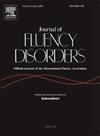Differential tolerance for the judgement of dysfluencies as stuttered speech in native and non-native speech-language pathologists
IF 2.1
3区 医学
Q1 AUDIOLOGY & SPEECH-LANGUAGE PATHOLOGY
引用次数: 0
Abstract
Purpose
Accurate diagnosis of stuttering requires careful observation by trained professionals. Speech-language pathologists (SLPs) typically identify stuttering using a perceptual judgement. However, it is unclear if this perception is based on the amount or the type of dysfluencies. Hence, the study aimed to determine the frequency of syllable/part-word repetitions judged as stuttered and to determine if the listener's language influences their judgement of fluency.
Method
Narrative samples of a Kannada-speaking child who stutters containing 1 %, 3 %, 5 %, 10 %, and 15 % of syllable or part-word repetitions were judged by 27 Kannada and Malayalam-speaking SLPs each as fluent, disfluent, or stuttered. Further, an opinion about recommending the child for speech therapy was taken. The chi-square test and Fisher's exact test were performed to compare the difference between the two groups.
Results
Comparison between the five frequencies of dysfluencies and the judgement of speech revealed a significant difference for Kannada and Malayalam language groups. The non-native SLPs required more dysfluencies to judge speech as stuttered compared to the native SLPs. Both groups of SLPs recommended speech therapy for samples above 5 % dysfluencies.
Conclusions
Familiarity of Malayalam-speaking SLPs with the Kannada language and the experience of the participants in the assessment of stuttering could have influenced the differences obtained in this study. However, current results indicate a differential threshold for the perception of dysfluencies (syllable and part-word repetitions) and the influence of the listener's language familiarity. Hence, language familiarity may be a factor in the judgement of dysfluencies as fluent, disfluent, and stuttered speech.
母语和非母语语言病理学家对言语不流利判断的差异容忍
目的:结巴的准确诊断需要经过专业训练的专业人员仔细观察。语言病理学家(slp)通常使用感知判断来识别口吃。然而,目前尚不清楚这种看法是基于不流利的数量还是类型。因此,本研究旨在确定被判断为口吃的音节/部分单词重复的频率,并确定听者的语言是否会影响他们对流利程度的判断。方法用27名说卡纳达语和马拉雅拉姆语的slp分别判断1 %、3 %、5 %、10 %和15 %的音节或部分单词重复的卡纳达语口吃儿童的叙述样本为流利、不流利或口吃。此外,还提出了建议孩子进行语言治疗的意见。采用卡方检验和Fisher精确检验比较两组间的差异。结果比较五种不流畅频率与言语判断的差异,发现卡纳达语和马拉雅拉姆语组存在显著差异。与母语的语言障碍者相比,非母语的语言障碍者需要更多的流利障碍来判断言语是否结巴。两组slp都建议对5% %以上的语言障碍患者进行语言治疗。结论说马拉雅拉姆语的slp对卡纳达语的熟悉程度和参与者在口吃评估中的经验可能影响了本研究得出的差异。然而,目前的研究结果表明,对不流畅(音节和部分单词重复)的感知和听者语言熟悉程度的影响存在差异阈值。因此,语言熟悉程度可能是判断流利、不流利和结巴等语言障碍的一个因素。
本文章由计算机程序翻译,如有差异,请以英文原文为准。
求助全文
约1分钟内获得全文
求助全文
来源期刊

Journal of Fluency Disorders
AUDIOLOGY & SPEECH-LANGUAGE PATHOLOGY-REHABILITATION
CiteScore
3.70
自引率
14.30%
发文量
23
审稿时长
>12 weeks
期刊介绍:
Journal of Fluency Disorders provides comprehensive coverage of clinical, experimental, and theoretical aspects of stuttering, including the latest remediation techniques. As the official journal of the International Fluency Association, the journal features full-length research and clinical reports; methodological, theoretical and philosophical articles; reviews; short communications and much more – all readily accessible and tailored to the needs of the professional.
 求助内容:
求助内容: 应助结果提醒方式:
应助结果提醒方式:


